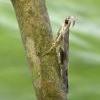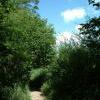35.018 Hypatima rhomboidella (Linnaeus, 1758)
Status and Distribution
Common and widespread across the British Isles and Channel Islands. Apparently absent from Orkney, Shetland and the Outer Hebrides.
Provisional map
Larva
Pupa
Foodplant and Larval Feeding Signs
Betula spp. including B. pendula (silver birch), and Corylus avellana (hazel), see plant distribution map for hazel. In Europe also recorded on Alnus glutinosa (alder), Carpinus betulus (hornbeam) and Populus tremula (aspen).
The larva feeds within a longitudinally rolled leaf.
Habitat
Finding the Moth
Larva: within rolled leaves from May to early July.
Adult: can be disturbed from trees during the day, flies at night and comes readily to light.
Similar Species
The long thin shape of the moth and the distinctive dark costal triangle on a pale background make this a distinctive species.
From July to mid-October; has on rare occasions been found in May, June and as late as mid-November.





